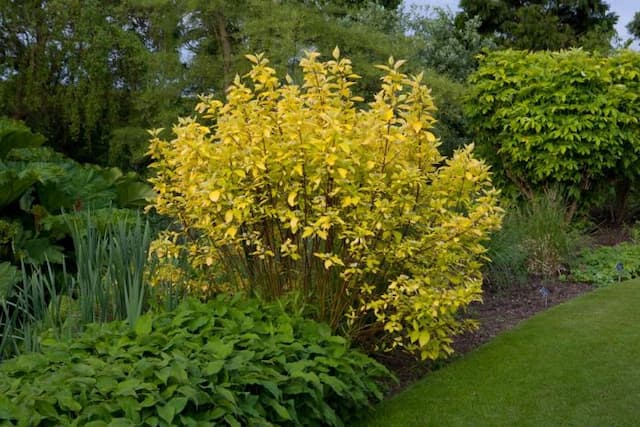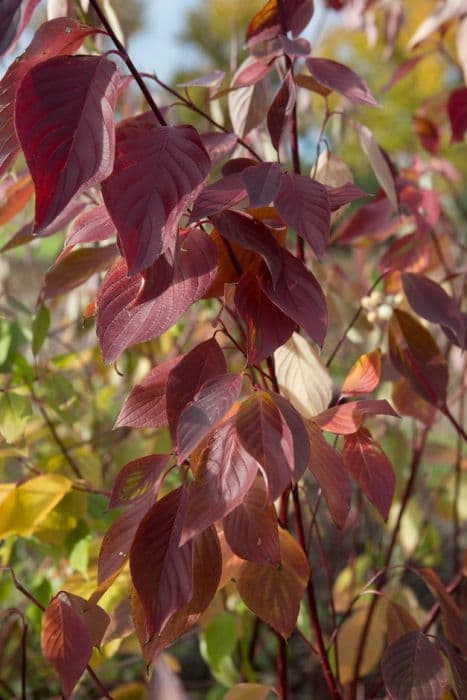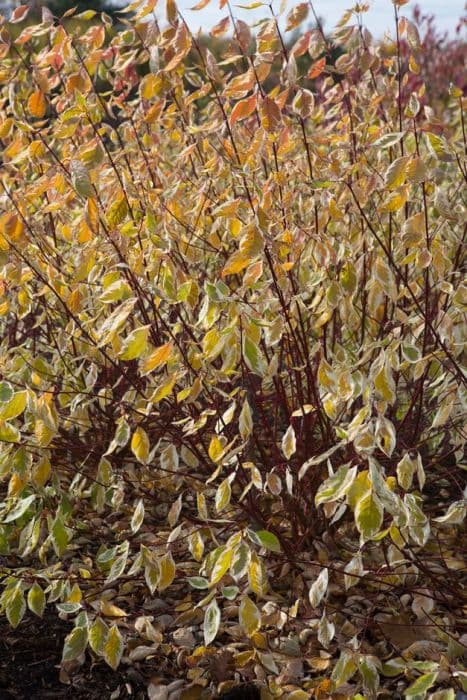Red Twig Dogwood Cornus 'Ascona'

ABOUT
The Cornus 'Ascona', commonly known as a type of Dogwood, is a visually striking plant. Its appearance is characterized by its elegant, arching branches which create a distinctive, layered look. The foliage of this Dogwood is lush, with leaves that are typically green and may turn to a range of vibrant colors in the fall, such as red or purple, providing a spectacular seasonal display. One of the most notable features of the Cornus 'Ascona' is its flowers. These blossoms are small but are clustered in large, showy bracts that can be white, pink, or even a creamy yellow, depending on the variety. These flowers are star-like in shape and create a stunning visual effect when the plant is in full bloom. Following the flowering season, the Dogwood produces ornamental fruit that can be a source of food for local wildlife. The fruits are typically berry-like and can be a bright red or blue, adding another layer of interest to the plant's appearance. The bark of the Cornus 'Ascona' is also distinctive, often exfoliating or peeling in patterns that reveal underlying colors and textures. This feature adds winter interest when the leaves have fallen, and the intricate structure of the branches is more visible. Overall, the Dogwood's structure, with its attractive flowers, colorful foliage, fruit, and textured bark, makes it a stunning plant with multi-seasonal appeal that can serve as an eye-catching addition to any landscape.
About this plant
 Names
NamesFamily
Cornaceae
Synonyms
Ascona Dogwood
Common names
Cornus 'Ascona'
 Toxicity
ToxicityTo humans
Cornus 'Ascona', commonly known as dogwood, is not generally considered toxic to humans. However, eating large quantities of the tree parts, particularly the fruit, might cause mild to moderate gastrointestinal upset, with symptoms such as nausea, vomiting, or diarrhea.
To pets
Dogwood, the common name for Cornus 'Ascona', is not typically toxic to pets. However, ingesting large amounts of the wood or leaves might lead to gastrointestinal discomfort in some animals, presenting with symptoms like vomiting or diarrhea. It is always best to discourage pets from chewing on any non-food plants.
 Characteristics
CharacteristicsLife cycle
Perennials
Foliage type
Deciduous
Color of leaves
Varies
Flower color
White
Height
6-8 feet (1.8-2.4 meters)
Spread
6-8 feet (1.8-2.4 meters)
Plant type
Shrub
Hardiness zones
5
Native area
Europe
Benefits
 General Benefits
General Benefits- Attractive Flowers: Cornus 'Ascona' produces star-shaped blossoms that add a decorative touch to gardens.
- Seasonal Interest: With a variety of seasonal changes, it offers year-round interest from spring flowers to colorful fall foliage and sometimes winter berries.
- Ease of Cultivation: It is relatively easy to grow in a range of soil types and is tolerant of different soil conditions.
- Wildlife Attraction: The flowers, fruits, and foliage attract birds and butterflies, promoting biodiversity.
- Drought Resistance: Once established, it can be quite drought tolerant, reducing the need for frequent watering.
- Landscape Versatility: It works well in different landscape designs, from specimen planting to foundation plantings, and can be used in mixed borders or as a focal point.
- Low Maintenance: Generally, it requires minimal pruning and care once established in the landscape.
- Shade Tolerance: It can grow in full sun to part shade, offering flexibility in garden design and planting location.
- Foliage: Offers attractive foliage which can come in green, variegated, or other colors depending on the variety.
 Medical Properties
Medical PropertiesThis plant is not used for medical purposes.
 Air-purifying Qualities
Air-purifying QualitiesThis plant is not specifically known for air purifying qualities.
 Other Uses
Other Uses- Cornus 'Ascona', commonly known as the Red Twig Dogwood, can be utilized in basket weaving due to its flexible branches which can be easily manipulated into various shapes.
- The Red Twig Dogwood's wood can be used to make small handcrafted items like tool handles, knitting needles, or crochet hooks as it is quite sturdy once dried.
- The colorful red branches of the Red Twig Dogwood are often used in floral arrangements or as standalone decorations during the winter, adding vibrancy to otherwise stark settings.
- In a wildlife garden, the Red Twig Dogwood can serve as a habitat plant, offering shelter and nesting sites for birds and small mammals.
- The spreading roots of the Red Twig Dogwood help with erosion control on slopes or riverbanks, stabilizing soil and preventing sediment runoff.
- Planting Red Twig Dogwood in a rain garden can assist with water management, as its roots help absorb excess runoff and mitigate flooding.
- During the fall, the Red Twig Dogwood's leaves can be collected and used to create natural mulch for garden beds, providing nutrients as they decompose.
- The high contrast between the Red Twig Dogwood's red stems and green leaves can be used in the art world, for instance as a natural stencil or pattern for fabric design.
- The tree is often used in educational settings as an example of a native plant species to teach about local biodiversity and the importance of native landscaping for ecosystem health.
- Red Twig Dogwood can act as a natural snow fence in colder regions, with its dense branching pattern slowing down and capturing drifting snow.
Interesting Facts
 Feng Shui
Feng ShuiThe Dogwood is not used in Feng Shui practice.
 Zodiac Sign Compitability
Zodiac Sign CompitabilityThe Dogwood is not used in astrology practice.
 Plant Symbolism
Plant Symbolism- Stability and Endurance: Cornus, commonly known as Dogwood, has a reputation for strong wood and resilient blossoms, symbolizing one's ability to withstand various challenges in life.
- Purity and Innocence: The Dogwood's often white and vibrant flowers are associated with these virtues, reflecting the plant's clean and simple beauty.
- Christian Symbolism: In Christian symbolism, the Dogwood is thought to represent the crucifixion of Jesus, with its flower petals shaped like a cross and the rusty indentations on the edges believed to signify the crucifixion nails.
- Renewal and Resurrection: Blooming in early spring, Dogwoods signify rebirth and the resurrection of nature, similar to Easter traditions in Christian contexts.
- Affection and Sympathy: Giving Dogwood flowers is often a sign of affection or sympathy, expressing love and comfort to the recipients.
 Water
WaterThe Red Twig Dogwood should be watered deeply once a week, applying about 1 to 1.5 inches of water each time, ensuring moisture reaches the deep roots. During hot, dry spells, watering frequency should increase to twice a week. Newly planted shrubs require consistent moisture and may need watering every few days until they are established, usually during the first growing season. Adjust the watering schedule during the fall and winter months when the plant is dormant, as it will require less water. Always check the soil moisture level before watering to prevent overwatering, as soggy soil can lead to root rot.
 Light
LightThe Red Twig Dogwood thrives best in a spot that receives full sun to partial shade. Ideally, it should get at least 4 hours of direct sunlight daily, but it can tolerate some shade, especially in the afternoon when the sun is strongest. A location that provides morning sunlight and afternoon shade can help prevent the leaves from scorching in areas with intense summer heat.
 Temperature
TemperatureThe Red Twig Dogwood is hardy and can tolerate a wide range of temperatures, withstanding minimum temperatures down to -30°F. It grows optimally in temperatures between 59°F and 77°F. The plant can survive up to maximum temperatures of around 95°F but may need additional watering and protection from extreme heat to prevent stress.
 Pruning
PruningPrune the Red Twig Dogwood in late winter or early spring to remove any dead or damaged branches and to encourage vibrant stem color, as the younger stems exhibit the brightest hues. It's beneficial to periodically remove about a third of the oldest stems to promote new growth, which should be done every 2-3 years. In addition to promoting aesthetic appeal, pruning also improves air circulation, which helps prevent disease.
 Cleaning
CleaningAs needed
 Soil
SoilDogwood 'Ascona' prefers a well-draining acidic soil with pH 5.5-6.0. A mix of garden soil, peat moss, and perlite or sand ensures proper drainage and aeration.
 Repotting
RepottingThe Dogwood 'Ascona' typically requires repotting every 2 to 3 years to refresh the soil and accommodate root growth.
 Humidity & Misting
Humidity & MistingDogwood 'Ascona' thrives in moderate humidity levels, around 30-50%, which are often found in typical outdoor environments.
 Suitable locations
Suitable locationsIndoor
Provide bright light, slight humidity, and cool temperatures for Dogwood.
Outdoor
Plant in well-draining soil, partial sun, and protect from extreme cold.
Hardiness zone
5-8 USDA
 Life cycle
Life cycleAfter seed germination, the Cornus 'Ascona', commonly known as a type of Dogwood, begins its life as a seedling, establishing a root system and sprouting initial leaves. As it enters the vegetative stage, it develops a woody stem and branches, expanding its foliage and increasing in height and spread. The plant then matures and enters the flowering stage, typically in spring, producing small, star-shaped flowers surrounded by large, showy bracts which can be white, pink, or yellow depending on the variety. Following pollination, these flowers develop into fruit, usually small, berry-like drupes that can attract birds and wildlife. In autumn, Dogwoods often display vibrant foliage colors before entering a period of dormancy in winter, shedding leaves in preparation for the cold. The cycle resumes in spring as the plant breaks dormancy with new growth, initiating the next cycle of flowering and fruiting.
 Propogation
PropogationPropogation time
Spring-Early Summer
Propogation: The most popular method of propagating Cornus 'Ascona', also known as a variety of Kousa dogwood, is through softwood cuttings. This technique is typically employed during late spring or early summer when the new growth is still soft and flexible. Softwood cuttings are taken from the current year’s growth, ensuring they are about 4 to 6 inches (10 to 15 cm) long with a few leaves at the top. The lower leaves are removed, and the cut end is dipped in a rooting hormone to promote root development. The cutting is then planted in a well-draining soil mix, ensuring at least one pair of leaf nodes is below the surface. A plastic bag or a propagator can be used to cover the cutting to maintain high humidity levels and provide a mini-greenhouse effect. Consistent moisture and warmth are important until the cutting establishes roots, which usually takes a few weeks.

![Dogwood [Baton Rouge]](/_next/image?url=https%3A%2F%2Fplants-admin.emdemapps.com%2Fimages%2Fplants%2F%2Fimages%2F604b59cf0fefd.png&w=640&q=75)


![Dogwood [Ivory Halo]](/_next/image?url=https%3A%2F%2Fplants-admin.emdemapps.com%2Fimages%2Fplants%2F%2Fimages%2F604b535cbcb9a.png&w=640&q=75)




![Dogwood [Venus]](/_next/image?url=https%3A%2F%2Fplants-admin.emdemapps.com%2Fimages%2Fplants%2F%2Fimages%2F604b58a531da1.png&w=640&q=75)